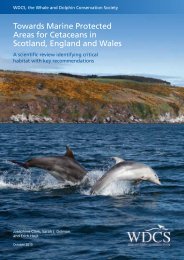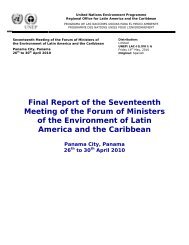Sea Turtle Recovery Action Plan for Barbados - WIDECAST
Sea Turtle Recovery Action Plan for Barbados - WIDECAST
Sea Turtle Recovery Action Plan for Barbados - WIDECAST
Create successful ePaper yourself
Turn your PDF publications into a flip-book with our unique Google optimized e-Paper software.
<strong>Barbados</strong> <strong>Sea</strong> <strong>Turtle</strong>s …<br />
4.27 Determine incidental catch and promote the use of TEDs<br />
There is no local or <strong>for</strong>eign shrimping around <strong>Barbados</strong>. Commercial trawling does not<br />
there<strong>for</strong>e pose a threat to sea turtles locally and there is no reason to promote the use of a<br />
trawl-inserted <strong>Turtle</strong> Excluder Device (TED). There are presently about six local long-liners<br />
(swordfish and other oceanic fish) in operation, but <strong>for</strong>eign long-liners also fish illegally in<br />
<strong>Barbados</strong>' territorial waters. The amount of sea turtle mortality associated with long-lining is<br />
unknown and should be investigated. The capture of leatherback turtles by long-lines has been<br />
documented elsewhere in the Caribbean, such as in the British Virgin Islands (Cambers and<br />
Lima, 1990).<br />
4.28 Supplement reduced populations using management techniques<br />
There are few data as yet to enable the specific costs and benefits of management options<br />
to be evaluated. In general, however, the protection of important nesting and feeding grounds in<br />
conjunction with a ban on harvest should provide a basis <strong>for</strong> sustained sea turtle recovery in<br />
<strong>Barbados</strong>. Some specific management practices (e.g., moving nests threatened by the sea or in<br />
danger of being poached, collecting and releasing hatchlings disoriented by beach lighting) are<br />
already in use. Should other ef<strong>for</strong>ts be deemed desirable, methodology should follow that<br />
described in the Manual of <strong>Sea</strong> <strong>Turtle</strong> Research and Conservation Techniques (Pritchard et al.,<br />
1983). <strong>WIDECAST</strong> personnel are available to provide advice and assistance in the design and<br />
implementation of specific management techniques. The protection of habitat can also constitute<br />
an important management decision. Solutions to several common habitat threats are provided<br />
under subheadings in sections 4.13 and 4.14. An example of important habitat is the <strong>Barbados</strong><br />
Hilton to Ocean View stretch of beach, which is the most important nesting site on the south<br />
coast (section 4.112); a specific turtle management plan is recommended <strong>for</strong> this site.<br />
4.29 Monitor stocks<br />
4.291 Nests<br />
The first quantitative estimate of nesting frequency in <strong>Barbados</strong> was made in 1987. The<br />
heavy pedestrian use of most beaches combined with the relative faintness of hawksbill tracks<br />
made aerial survey techniques inappropriate <strong>for</strong> west coast and south coast beaches, so members<br />
of the <strong>Barbados</strong> Environmental Association (BEA) divided themselves into eight groups and<br />
walked around the whole island on three separate occasions (June, July, August). The divisions<br />
were such that the groups could walk their designated route between 0530-0730 hrs, prior to<br />
human activity on beaches. All nests and false crawls were recorded by each group, as was the<br />
position of the nest, evidence of poaching, and any potential threats such as lights, nearby storm<br />
drains, etc. Any nests that were considered to be threatened by erosion, freshwater flooding or<br />
building development were relocated as soon as possible (

















